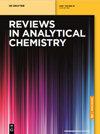环境纳米和亚微米颗粒的分离与表征
IF 3.8
3区 化学
Q2 CHEMISTRY, ANALYTICAL
引用次数: 18
摘要
环境纳米和亚微米颗粒的研究是评估其对环境和人类健康影响以及了解各种自然和人为过程的必要条件。纳米和亚微米颗粒具有更高的流动性,可以作为有毒物质和营养物质的“载体”,因此特别令人感兴趣。到目前为止,人们对环境中纳米和亚微米粒子的来源、行为、命运和毒性还缺乏认识。本文主要介绍了目前对其进行研究的分离和表征方法。讨论了沉降、离心、膜过滤、场和流技术在纳米和亚微米颗粒分离中的应用。简要总结了这些技术的优点和局限性。在表征/分析方法中,特别关注的是电子显微镜,光散射以及原子吸收光谱,光学发射和质谱。本文章由计算机程序翻译,如有差异,请以英文原文为准。
Separation and characterization of environmental nano- and submicron particles
Abstract The investigation of environmental nano- and submicron particles is needed for the assessment of their impact on the environment and human health as well as for understanding various natural and anthropogenic processes. Nano- and submicron particles have an increased mobility, may serve as a “carrier” for toxic and nutrient substances, and hence are of particular interest. So far, there is a lack of knowledge about source, behavior, fate, and toxicity of environmental nano- and submicron particles. This article is focused on the separation and characterization methods, which are currently used for their investigation. The application of sedimentation, centrifugation, membrane filtration, and field- and flow-based techniques to the separation of nano- and submicron particles are discussed. The advantages and limitations of the techniques are briefly summarized. Among characterization/analysis methods, a special attention is given to electron microscopy, light scattering as well as atomic absorption spectroscopy, optical emission, and mass spectrometry.
求助全文
通过发布文献求助,成功后即可免费获取论文全文。
去求助
来源期刊

Reviews in Analytical Chemistry
化学-分析化学
CiteScore
7.50
自引率
0.00%
发文量
15
审稿时长
>12 weeks
期刊介绍:
Reviews in Analytical Chemistry publishes authoritative reviews by leading experts in the dynamic field of chemical analysis. The subjects can encompass all branches of modern analytical chemistry such as spectroscopy, chromatography, mass spectrometry, electrochemistry and trace analysis and their applications to areas such as environmental control, pharmaceutical industry, automation and other relevant areas. Review articles bring the expert up to date in a concise manner and provide researchers an overview of new techniques and methods.
 求助内容:
求助内容: 应助结果提醒方式:
应助结果提醒方式:


